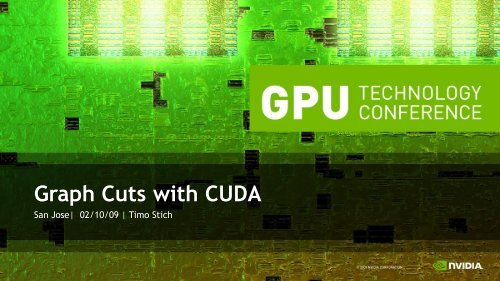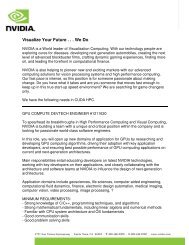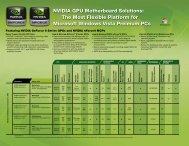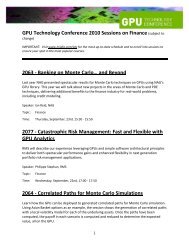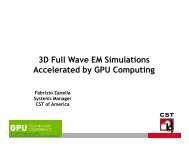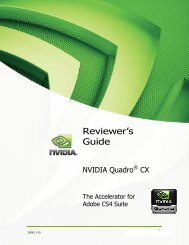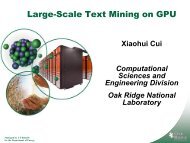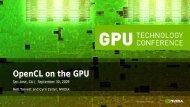Graph Cuts with CUDA
Graph Cuts with CUDA
Graph Cuts with CUDA
You also want an ePaper? Increase the reach of your titles
YUMPU automatically turns print PDFs into web optimized ePapers that Google loves.
<strong>Graph</strong> <strong>Cuts</strong> <strong>with</strong> <strong>CUDA</strong><br />
San Jose| 02/10/09 | Timo Stich
Outline<br />
• Introduction<br />
• Algorithms to solve <strong>Graph</strong> <strong>Cuts</strong><br />
• <strong>CUDA</strong> implementation<br />
• Image processing application<br />
• Summary
Problems solvable <strong>with</strong> <strong>Graph</strong>cuts<br />
Stereo Depth Estimation Binary Image Segmentation<br />
Photo Montage (aka Image Stitching)<br />
Source: MRF Evaluation, Middlebury College
Energy Minimization<br />
• <strong>Graph</strong>cut finds global minimum<br />
Sum over all Pixels of an Image<br />
E(<br />
L)<br />
x<br />
D<br />
x<br />
( L<br />
x<br />
Data Term:<br />
Measures fitting of<br />
label to pixel<br />
)<br />
( x,<br />
y)<br />
Sum over all neighborhoods<br />
V<br />
(|<br />
L<br />
x<br />
L<br />
y<br />
|)<br />
Neighborhood Term:<br />
Penalizes different labelings<br />
for neighbors
Example:<br />
Binary Segmentation Problem<br />
User marks some pixels as<br />
Background and Foreground<br />
0 0 0 0<br />
? ? ? ?<br />
? ? ? ?<br />
? ? ? 1<br />
Compute for all pixels if they<br />
are Background or Foreground
Building a Flow <strong>Graph</strong> for the Problem<br />
Pixels<br />
Da<br />
( 1)<br />
Source<br />
D b(<br />
1)<br />
D ( 1)<br />
c<br />
V a,b<br />
( 1)<br />
V b,c<br />
( 1)<br />
V c,d<br />
( 1)<br />
Vd<br />
,e ( 1)<br />
a b<br />
c<br />
d e<br />
Da<br />
( 0)<br />
Db<br />
( 0)<br />
Dc<br />
( 0)<br />
Sink<br />
Dd<br />
( 1)<br />
Dd<br />
( 0)<br />
De<br />
( 1)<br />
De<br />
( 0)<br />
....
Maximum Flow = Minimum Cut<br />
Source<br />
Pixels a b<br />
c<br />
d e ....<br />
Sink
Pixels<br />
<strong>Graph</strong> Cut Solution<br />
Source<br />
Sink<br />
....
<strong>Graph</strong> Cut Solution<br />
Input Result
<strong>Graph</strong> Cut Algorithms<br />
• Ford-Fulkerson<br />
– Find augmenting paths from source to sink<br />
– Global scope, based on search trees<br />
– Most used implementation today by Boykov et al.<br />
• Goldberg-Tarjan (push-relabel)<br />
– Considers one node at a time<br />
– Local scope, only direct neighbors matter<br />
– Inherently parallel, good fit for <strong>CUDA</strong>
Push-Relabel in a nutshell<br />
• Some definitions<br />
– Each node x:<br />
• Has excess flow u(x) and height h(x)<br />
• Outgoing edges to neighbors (x,*) <strong>with</strong> capacity c(x,*)<br />
– Node x is active: if u(x)> 0 and h(x)< HEIGHT_MAX<br />
– Active node x<br />
• can push to neighbor y: if c(x,y) > 0, h(y) = h(x) – 1<br />
• is relabeled: if for all c(x,*) > 0, h(*) >= h(x)
Push Pseudocode<br />
void push(x, excess_flow, capacity, const height)<br />
if active(x) do<br />
done<br />
foreach y=neighbor(x)<br />
end<br />
if height(y) == height(x) – 1 do // check height<br />
done<br />
flow = min( capacity(x,y), excess_flow(x)); // pushed flow<br />
excess_flow(x) -= flow; excess_flow(y) += flow; // update excess flow<br />
capacity(x,y) -= flow; capacity(y,x) += flow; // update edge cap.
Relabel Pseudocode<br />
void relabel(x, height, const excess_flow, const capacity)<br />
if active(x) do<br />
done<br />
my_height = HEIGHT_MAX; // init to max height<br />
foreach y=neighbor(x)<br />
end<br />
if capacity(x,y) > 0 do<br />
my_height = min(my_height, height(y)+1); // minimum height + 1<br />
done<br />
height(x) = my_height; // update height
Push-Relabel Pseudocode<br />
while any_active(x) do<br />
done<br />
foreach x<br />
end<br />
relabel(x);<br />
foreach x<br />
end<br />
push(x);
<strong>Graph</strong> setup<br />
Excess Flow Height<br />
3<br />
Source<br />
9 5 6<br />
3/3 3/3 4/4 1/1<br />
0/0 0/0<br />
0/0<br />
0/0 0/0<br />
10<br />
2 1<br />
Sink<br />
8<br />
9<br />
2<br />
1<br />
1
Direct Push<br />
10 - 3 = -7<br />
3<br />
Source<br />
9 10 6<br />
3/3 3/3 4/4 1/1<br />
-7/0 0/0 0/0<br />
0/0<br />
0/0 0/0<br />
10<br />
2 1<br />
Sink<br />
8<br />
9<br />
2<br />
Total flow = 30
Initialized<br />
HEIGHT_MAX = 5<br />
Source<br />
3/3 3/3 4/4 1/1<br />
-7/0 7/0<br />
4/0<br />
-2/0 -7/0<br />
active<br />
Sink<br />
Total flow = 14
After Relabel<br />
Source<br />
3/3 3/3 4/4 1/1<br />
-7/0 7/1<br />
4/1<br />
-2/0 -7/0<br />
Sink<br />
Total flow = 14
After Push<br />
Source<br />
6/0 3/3 0/8 1/1<br />
-4/0 4/1<br />
0/1<br />
2/0 -7/0<br />
Sink<br />
Total flow = 19
2 nd iteration<br />
Source<br />
6/0 3/3 0/8 1/1<br />
-4/0 4/1<br />
0/1<br />
2/0 -7/0<br />
Sink<br />
Total flow = 19
After Relabel<br />
Source<br />
6/0 3/3 0/6 1/1<br />
-4/0 4/2<br />
0/1<br />
2/1 -7/0<br />
Sink<br />
Total flow = 19
After Push<br />
Source<br />
6/0 0/6 0/6 0/2<br />
-4/0 1/2<br />
3/1<br />
1/1 -6/0<br />
Sink<br />
Total flow = 20
After 3 more Iterations, Terminated<br />
Source<br />
6/0 0/6 0/6 0/2<br />
-4/0 1/5<br />
3/5<br />
1/5 -6/0<br />
Sink<br />
Total flow = 20
Inverse BFS from Sink<br />
Source<br />
6/0 0/2<br />
-4/0 X 1/5<br />
3/5<br />
1/1 X -6/0<br />
Sink<br />
Total flow = 20
<strong>Graph</strong> Cut and Solution<br />
3<br />
Source<br />
9 5 6<br />
3 3 4 1<br />
a b<br />
c<br />
d e<br />
10<br />
2 1<br />
Sink<br />
8<br />
9<br />
2<br />
Total flow = 20<br />
Minimum Cut = 20 = Maximum Flow
<strong>Graph</strong> <strong>Cuts</strong> for Image Processing<br />
• Regular <strong>Graph</strong>s <strong>with</strong> 4-Neighborhood<br />
• Integers<br />
• Naive approach<br />
– One thread per node<br />
– Push Kernel<br />
– Relabel Kernel<br />
S<br />
T
<strong>CUDA</strong> Implementation<br />
• Datastructures<br />
– 4 WxH arrays for residual edge capacities<br />
– 2 WxH array for heights (double buffering)<br />
– WxH array for excess flow
Push Data Access Patterns<br />
• Read/Write: Excess Flow, Edge capacities<br />
• Read only : Height<br />
Excess Flow Data
Relabel Data Access Patterns<br />
• Read/Write: Height (Texture, double buffered)<br />
• Read only : Excess Flow, Edge capacities<br />
Height Data
Data Access Patterns<br />
• Push does scattered write:<br />
Needs global atomics to avoid RAW Hazard!
Naive <strong>CUDA</strong> Implementation<br />
• Iterative approach:<br />
• Repeat<br />
– Push Kernel (Updates excess flow & edge capacities)<br />
– Relabel Kernel (Updates height)<br />
• Until no active pixels are left
Naive <strong>CUDA</strong> Implementation<br />
• Both kernels are memory-bound<br />
• Observations on the naive implementation<br />
– Push: Atomic memory bandwidth is lower<br />
– Relabel: 1-bit per edge would be sufficient<br />
Addressing these bottlenecks improves overall performance
Push, improved<br />
• Idea:<br />
– Work on tiles in shared memory<br />
• Share data between threads of a block<br />
– Each thread updates M pixels<br />
• Push first M times in first edge direction<br />
• Then M times in next edge direction
Wave Push<br />
Active Thread<br />
Push direction<br />
Excess Flow Data-Tile in Shared Memory<br />
M<br />
ef = 0;<br />
for k=0...M-1<br />
ef += s_ef(k)<br />
flow = min(right(x+k),ef)<br />
right(x+k)-=flow;<br />
s_ef(k)=ef-flow;<br />
ef = flow;<br />
end
Wave Push<br />
Active Thread<br />
Push direction<br />
Flow is carried along by each thread<br />
ef = 0;<br />
for k=0...M-1<br />
ef += s_ef(k)<br />
flow = min(right(x+k),ef)<br />
right(x+k)-=flow;<br />
s_ef(k)=ef-flow;<br />
ef = flow;<br />
end
Wave Push<br />
Active Thread<br />
Push direction<br />
ef = 0;<br />
for k=0...M-1<br />
ef += s_ef(k)<br />
flow = min(right(x+k),ef)<br />
right(x+k)-=flow;<br />
s_ef(k)=ef-flow;<br />
ef = flow;<br />
end
Wave Push<br />
Active Thread<br />
Push direction<br />
Border
Wave Push<br />
Active Thread<br />
Push direction<br />
Do the same for other directions
Wave Push<br />
• After tile pushing, border is added<br />
• Benefits<br />
– No atomics necessary<br />
– Share data between threads<br />
– Flow is transported over larger distances
Relabel<br />
• Binary decision: capacity > 0 ? 1 : 0<br />
• Idea: Compress residual edges as bit-vectors<br />
– Compression computed during push
Relabel<br />
5<br />
0<br />
3<br />
9<br />
0<br />
0<br />
1<br />
7<br />
• Compression Ratio: 1:32 (int capacities)<br />
1<br />
0<br />
1<br />
1<br />
0<br />
0<br />
1<br />
1
<strong>CUDA</strong> Implementation<br />
• Algorithmic observations<br />
– Most parts of the graph will converge early<br />
– Periodic global relabeling significantly reduces<br />
necessary iterations
Tile based push-relabel<br />
80%<br />
70%<br />
60%<br />
50%<br />
40%<br />
30%<br />
20%<br />
10%<br />
0%<br />
Active Pixels per Iteration<br />
1 2 3 4 5 6 7 8 9
Tile based push-relabel<br />
• Split graph in NxN pixel tiles (32x32)<br />
• If any pixel is active, the tile is active<br />
Tiles<br />
Pixels
Tile based push-relabel<br />
• Repeat<br />
– Build list of active tiles<br />
– For each active tile<br />
• Push<br />
• Relabel<br />
• Until no active tile left
Global Relabel<br />
• Local relabel is a bad heuristic for long distance<br />
flow transportation<br />
– Unnecessary pushing of flow back and forth<br />
• Global relabel is exact<br />
– Computes the correct geodesic distances<br />
– Flow will be pushed in the correct direction<br />
– Downside: costly operation
Global Relabel<br />
• BFS from sink<br />
– First step implicit -> multi-sink BFS<br />
• Implemented as local operator:
Global Relabel<br />
• Mechanisms from Push-Relabel can be reused:<br />
– Wave Updates<br />
– Residual <strong>Graph</strong> Compression<br />
– Tile based
Global Relabel<br />
• Initialize all pixels:<br />
– <strong>with</strong> flow < 0 to 0 (multi-sink BFS)<br />
– <strong>with</strong> flow >= 0 to infinity<br />
• Compress residual graph<br />
• Build active tile list<br />
• Repeat<br />
– Wave label update<br />
• Until no label changed
Final <strong>CUDA</strong> <strong>Graph</strong>cut<br />
• Repeat<br />
– Global Relabel<br />
– For H times do<br />
• Build active tile list<br />
• For each tile do push-relabel<br />
• Until no active tile
Results<br />
• Comparison between Boykov et al. (CPU),<br />
Cuda<strong>Cuts</strong> and our implementation<br />
– Intel Core2 Duo E6850 @ 3.00 GHz<br />
– NVIDIA Tesla C1060<br />
Dataset Boykov<br />
(CPU)<br />
Cuda<strong>Cuts</strong><br />
(GPU)<br />
Our<br />
(GPU)<br />
Flower (600x450) 191 ms 92 ms 20 ms 9.5x<br />
Sponge (640x480) 268 ms 59 ms 14 ms 19x<br />
Person (600x450) 210 ms 78 ms 35 ms 6x<br />
Average speedup over CPU is 10x<br />
Speedup<br />
Our vs CPU
Results<br />
Runtime (ms)<br />
8000<br />
7000<br />
6000<br />
5000<br />
4000<br />
3000<br />
2000<br />
1000<br />
0<br />
Average Speedup of 8.5 x<br />
0 2 4 6 8 10 12 14<br />
Image Size (Mega Pixels)<br />
Boykov et al (CPU)<br />
Our <strong>CUDA</strong> Impl. (GPU)
Example Application: GrabCut
GrabCut Application<br />
(Siggraph 2004 paper)<br />
• Based on Color models for FG and BG<br />
– User specifies a rectangle around the object to cut<br />
– Initialize GMM model of FG and BG colors<br />
– <strong>Graph</strong> Cut to find labeling<br />
– Use new labeling to update GMM<br />
– Iterate until convergence<br />
• Full <strong>CUDA</strong> implementation<br />
• Total runtime: ~25 ms per iteration -> 500 ms
Summary<br />
• Introduction to <strong>Graph</strong> <strong>Cuts</strong><br />
• Push-Relabel <strong>CUDA</strong> implementation<br />
– Beats CPU by 8.5 x on average<br />
• Makes full <strong>CUDA</strong> implementation of many image<br />
processing applications possible


